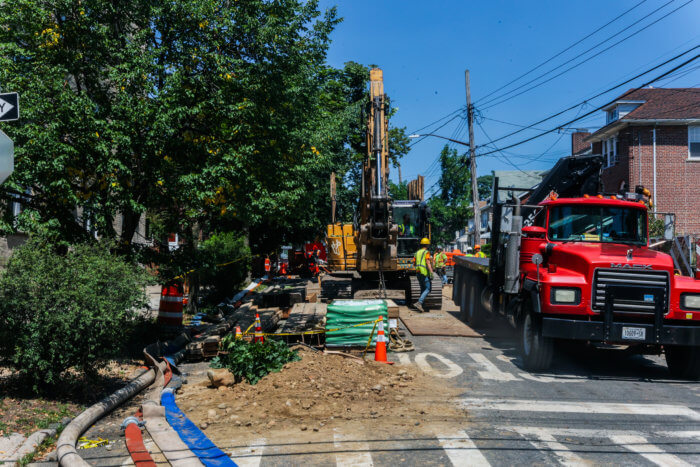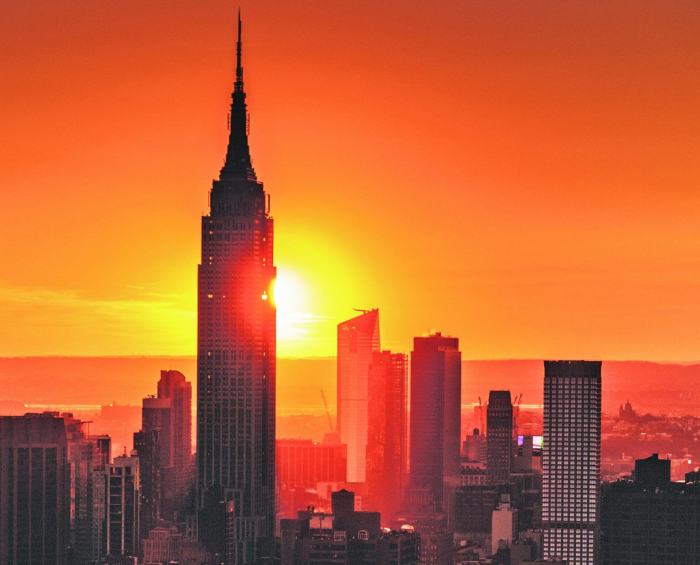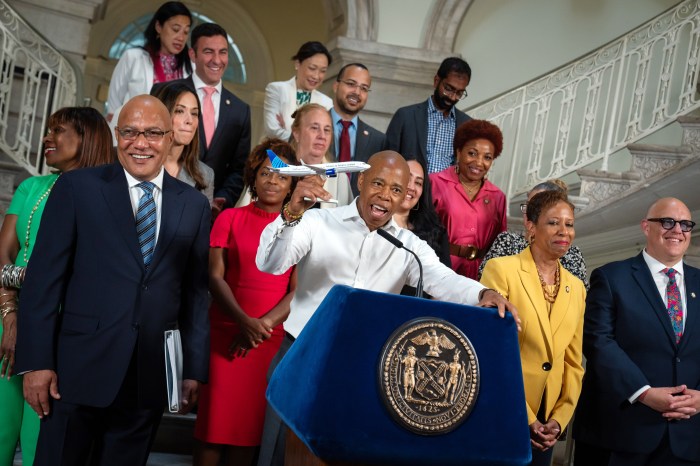A sinkhole the length of three cars on a Morris Park roadway late Monday morning caused a commotion both in the neighborhood and on social media — but luckily no injuries — when a WABC-TV van sunk into the ground in front of 1613 Radcliffe Avenue.
While the driver was able to leave unscathed, the sinkhole led to disrupted water service for 70 residents — in the middle of a blistering week-long heat stretch in the city — which has since been reduced to 20 Tuesday afternoon.
Sinkholes — depressions or holes in the ground with no natural drainage — intensify after severe rainfalls, a study in 2018 found, as water collects inside the sinkhole and drains into the subsurface.
With this week’s heat wave in full session, residents without water services are not surprised by last night’s sinkhole, citing long-standing issues with the Radcliffe Avenue infrastructure. After Monday’s furious rainfall, some residents resigned themselves to Radcliffe Avenue either being completely flooded or worse.
“This isn’t new. Whenever it rains, we get flooded, we complain to the city, and they do nothing about it. I didn’t think it would be a sinkhole, but something happening like that happening on this road isn’t a surprise,” said Steph Garcia, who lives in a Radcliffe Avenue apartment building that was without water at around 11:00 p.m. “But now it’s hot as hell and there’s no water, so it just seems like this city is somehow never prepared for any of this.”
Assemblymember Michael Benedetto noted was the second sinkhole occurrence on Radcliffe Avenue, in chats with his constituents.
“The NYC Department of Environmental Conservation needs to perform a thorough analysis of the underground utilities in the vicinity of this most recent street collapse,” said the longtime Assemblymember. “So far, the property damage has been minimal, but the situation could quickly become dire if the underlying issue is not addressed with the utmost urgency.”
Edward Timbers, spokesperson for the city’s Department of Environmental Protection (DEP) told the Bronx Times that they expect infrastructure work on the Radcliffe strip to take “several weeks.”
Sinkholes are hard to predict, and they aren’t tracked by the government.

Once rare, the past decade has seen a rise in sinkholes in the New York City, which geologists and studies have cited is due to a deeply outdated underground infrastructure that ranges around 60 years old.
In late March, Clinton Avenue residents in Crotona noted a gaping sinkhole started forming in, and DEP officials in April told the Bronx Times that it was likely caused by a broken pipe under the street.
However, unlike earthquakes or hurricanes, sinkholes aren’t tracked by government agencies from human-made causes. Most of the scientific research has focused on areas where limestone, caves and natural springs create prime conditions for earthen collapses, a prevalence in Florida.
A case study examining Florida in 2018 found that climate change increased sinkhole collapses in the Panhandle State, a link to intensifying weather events and the ability of aging infrastructure to withstand it.
“The occurrence frequency and intensity of many natural geohazards, such as landslides, debris flows and earthquakes, have increased in response to global warming,” the study conducted by researchers at Institute of Karst Geology found.
So far, the average global temperature on Earth has increased by a little more than 1° Celsius (2° Fahrenheit) since 1880, but projections show that we are on track for at least double that unless drastic change is expedited.
For every 0.1℃ rise in temperature, the number of sinkholes increases by 1%-3%, the study suggests.
In some cases, sinkholes — like a 15-foot drop in 2015 in Belmont from a decaying sidewalk vault that injured a man — levy harm on pedestrians. Some sinkholes, United States Geological Survey suggests, result from the land surface changing, such as when industrial and runoff-storage ponds are created.
In the interim, Bronx infrastructure is failing to beat the rain, as floods from heavy rainfall continue to overrun the fears and homes of Bronx residents. A few residents on the block said they were dealing with flooding from Monday night’s rainfall, which, according to the National Weather Service, drenched the borough in 3“-4” of rainfall with flash flooding warnings in just an hour.
A DEP spokesperson told the Bronx Times last month that hundreds of millions of dollars every year are allocated to upgrade and build out the city’s sewer system, but the frequent high-torrential downpours overload the city’s drainage system.
And beating the heat — the city’s health department says 370 New Yorkers die of heat related issues every year — has been a disparate struggle for Bronx neighborhoods, in particular. In their 2018 Heat Vulnerability Index, the city’s health department found that six of the city’s 12 most heat-vulnerable community districts resided in the Bronx.





















